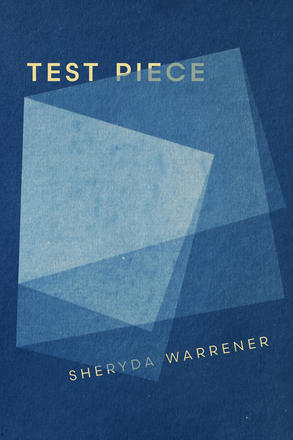Test Piece
By Sheryda Warrener
Coach House Books
80 pages, $23
A test piece, Sheryda Warrener informs her readers near the end of the collection, “is a record of an experiment/ with unconventional materials,” a trial run to see “how they might behave or/ transform under the duress of time.” Test Piece, Warrener’s third poetry collection, consists of nine pieces that are a cross between poems and poetic sequence.
This hybridity is due primarily to their length. The opening poem, “Crushed Velvet,” is the shortest piece in the collection. It also has the most concise narrative, unfolding like a movie scene in which the reader gets a preview of Warrener’s preoccupation with legibility and the creative potential that becomes available even as the speaker confesses: “Lacking fluency, I fail to register./ Desire a material time turns outside in.” The remaining poems have an airy quality as they spill across multiple pages and make Test Piece read much like a notebook that accompanies a test piece.
At the same time, the collection is also the work of art, in some sense quite literally. A part of Test Piece that is easy to overlook is the four images interspliced throughout the collection. On a visual level, these four images are collages. Handwritten notes and bits of paper and printed text mingle with scenes of a domestic interior: a view from a window onto a tree, a dining area, a bedroom, a living room. There is no context to these images. They capture the reader’s attention and turn them into a viewer, suggesting the two are not so different. These images are an invitation to linger and apply the same sense of careful consideration of the everyday as one would to a work of art.
Test Piece combines observation with a sense of an internal self-awareness about the malleability of poetic form and language. To be sure, there are moments when Warrener’s speaker notes things that might change a reader’s perception of art, like in “A Fixed Point,” where the speaker contemplates how “[t]he discovery of a carved female figure/ is considered invaluable not/ by surviving eight thousand years/ but by the rarity of its precise/ wholeness.” Yet Test Piece is not a treatise on art, nor is it a strictly ekphrastic work. Like the 1969 Eva Hesse piece that inspired both the collection title and the titular poem, “Test Piece for ‘Contingent,’” Warrener’s poetry is about testing the boundaries of perception. Unlike Hesse’s work, which will eventually deteriorate, Warrener builds this sense of breaking down into her poems to mimic the act of looking at a work of art. What is breaking down, in other words, is not the poem itself, but the reader’s expectations of where the work will lead them, and Warrener gives the reader the gift of that same technique—unravelling through looking—in everyday life.
—Margaryta Golovchenko














